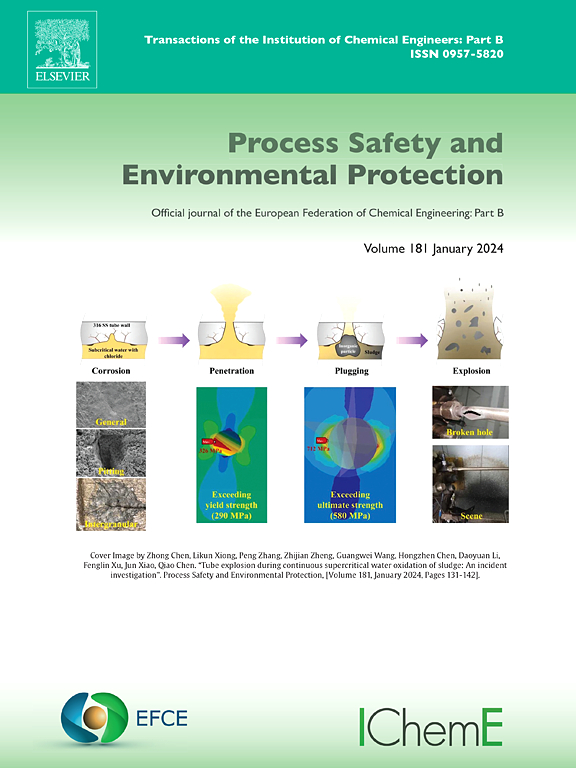基于多尺度随机模型的天然气管道事故碎片危害耦合评估与风险重构
IF 6.9
2区 环境科学与生态学
Q1 ENGINEERING, CHEMICAL
引用次数: 0
摘要
传统的天然气管道事故风险评估模型主要关注喷射火灾热辐射区,而由于碎片数量、质量和喷射轨迹的随机性难以量化,因此往往低估了由喷射碎片引起的二次危害。本文提出了一种整合碎片随机产生机制和物理抛射过程的多尺度耦合模型,以重新配置碎片灾害的动态传播路径和空间风险分布。通过对1954年至2024年全球95起管道破裂事件的统计分析,建立了碎屑数量、质量分布和抛射角度的概率数据库。采用内聚裂纹模型模拟碎屑生成过程,采用蒙特卡罗方法处理弹射参数的不确定性。通过对2009年加拿大安大略省管道破裂事件的验证,该模型预测97.2% %的碎片落在破裂地点150 m范围内,与观测到的最大喷射距离非常吻合。对管道100-4段进行全尺寸模拟,最大碎片飞行距离为263.6 m,超过ASME B31.8S标准计算的热辐射边界222.9 m。该研究揭示了传统热辐射模型对危险区域的系统性低估,并倡导将碎片动力学评估纳入智能管道安全管理系统。此外,提出的概率-物理耦合框架支持多灾害协同分析(例如,热辐射-碎片-土壤侵蚀相互作用),为碳中和背景下的高精度管道设计、弹性城市基础设施规划和能源运输风险缓解提供决策范式[49]。本文章由计算机程序翻译,如有差异,请以英文原文为准。
Coupled assessment and risk reconfiguration of debris hazards in natural gas pipeline incidents via multi-scale stochastic modeling
Traditional risk assessment models for natural gas pipeline incidents predominantly focus on jet fire thermal radiation zones, while secondary hazards caused by ejected debris—owing to challenges in quantifying the randomness of debris quantity, mass, and ejection trajectories—are often underestimated. This study proposes a multi-scale coupled model integrating stochastic debris generation mechanisms and physical ejection processes to reconfigure the dynamic propagation pathways and spatial risk distribution of debris hazards. Leveraging statistical analysis of 95 global pipeline rupture incidents from 1954 to 2024, we established a probabilistic database for debris quantity, mass distribution, and ejection angles. A cohesive crack model was employed to simulate debris generation, with Monte Carlo methods addressing ejection parameter uncertainties. Validated against the 2009 pipeline rupture incident in Ontario, Canada, the model predicted that 97.2 % of debris landed within 150 m of the rupture site, aligning closely with observed maximum ejection distances. Full-scale simulations for pipeline section 100–4 revealed a maximum debris flight distance of 263.6 m, surpassing the thermal radiation boundary (222.9 m) calculated by the ASME B31.8S standard. This study exposes the systemic underestimation of hazard zones by conventional thermal radiation models and advocates integrating debris dynamics assessments into intelligent pipeline safety management systems. Furthermore, the proposed probabilistic-physical coupling framework supports multi-hazard synergy analysis (e.g., thermal radiation-debris-soil erosion interactions), offering a decision-making paradigm for high-precision pipeline design, resilient urban infrastructure planning, and energy transportation risk mitigation in the context of carbon neutrality349.
求助全文
通过发布文献求助,成功后即可免费获取论文全文。
去求助
来源期刊

Process Safety and Environmental Protection
环境科学-工程:化工
CiteScore
11.40
自引率
15.40%
发文量
929
审稿时长
8.0 months
期刊介绍:
The Process Safety and Environmental Protection (PSEP) journal is a leading international publication that focuses on the publication of high-quality, original research papers in the field of engineering, specifically those related to the safety of industrial processes and environmental protection. The journal encourages submissions that present new developments in safety and environmental aspects, particularly those that show how research findings can be applied in process engineering design and practice.
PSEP is particularly interested in research that brings fresh perspectives to established engineering principles, identifies unsolved problems, or suggests directions for future research. The journal also values contributions that push the boundaries of traditional engineering and welcomes multidisciplinary papers.
PSEP's articles are abstracted and indexed by a range of databases and services, which helps to ensure that the journal's research is accessible and recognized in the academic and professional communities. These databases include ANTE, Chemical Abstracts, Chemical Hazards in Industry, Current Contents, Elsevier Engineering Information database, Pascal Francis, Web of Science, Scopus, Engineering Information Database EnCompass LIT (Elsevier), and INSPEC. This wide coverage facilitates the dissemination of the journal's content to a global audience interested in process safety and environmental engineering.
 求助内容:
求助内容: 应助结果提醒方式:
应助结果提醒方式:


